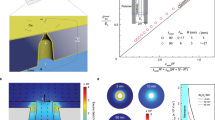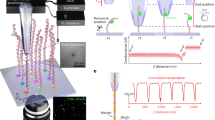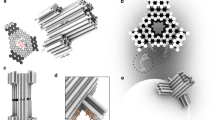Abstract
Nanopores can be used to detect and analyse biomolecules. However, controlling the translocation speed of molecules through a pore is difficult, which limits the wider application of these sensors. Here, we show that low-power visible light can be used to control surface charge in solid-state nanopores and can influence the translocation dynamics of DNA and proteins. We find that laser light precisely focused at a nanopore can induce reversible negative surface charge densities as high as 1 C m−2, and that the effect is tunable on submillisecond timescales by adjusting the photon density. By modulating the surface charge, we can control the amount of electroosmotic flow through the nanopore, which affects the speed of translocating biomolecules. In particular, a few milliwatts of green light can reduce the translocation speed of double-stranded DNA by more than an order of magnitude and the translocation speed of small globular proteins such as ubiquitin by more than two orders of magnitude. The laser light can also be used to unclog blocked pores. Finally, we discuss a mechanism to account for the observed optoelectronic phenomenon.
This is a preview of subscription content, access via your institution
Access options
Subscribe to this journal
Receive 12 print issues and online access
$259.00 per year
only $21.58 per issue
Buy this article
- Purchase on Springer Link
- Instant access to full article PDF
Prices may be subject to local taxes which are calculated during checkout




Similar content being viewed by others
References
Zhang, X., Ju, H. & Wang, J. Electrochemical Sensors, Biosensors and their Biomedical Applications (Elsevier, 2008).
Venkatesan, B. M. & Bashir, R. Nanopore sensors for nucleic acid analysis. Nature Nanotech. 6, 615–624 (2011).
Tegenfeldt, J. O. et al. The dynamics of genomic-length DNA molecules in 100-nm channels. Proc. Natl Acad. Sci. USA 101, 10979–10983 (2004).
Pang, P., He, J., Park, J., Krstic, P. S. & Lindsay, S. Origin of giant ionic currents in carbon nanotube channels. ACS Nano 5, 7277–7283 (2011).
Guan, W., Fan, R. & Reed, M. A. Field-effect reconfigurable nanofluidic ionic diodes. Nature Commun. 2, 506 (2011).
Dekker, C. Solid-state nanopores. Nature Nanotech. 2, 209–215 (2007).
Healy, K. Nanopore-based single-molecule DNA analysis. Nanomedicine 2, 459–481 (2007).
Wanunu, M. & Meller, A. in Laboratory Manual on Single Molecules (eds Ha, T. & Selvin, P.) 395–420 (Cold Spring Harbor Press, 2008).
Wong, C. T. A. & Muthukumar, M. Polymer capture by electro-osmotic flow of oppositely charged nanopores. J. Chem. Phys. 126, 164903 (2007).
He, Y., Tsutsui, M., Fan, C., Taniguchi, M. & Kawai, T. Controlling DNA translocation through gate modulation of nanopore wall surface charges. ACS Nano 5, 5509–5518 (2011).
Kejian, D., Weimin, S., Haiyan, Z., Xianglei, P. & Honggang, H. Dependence of zeta potential on polyelectrolyte moving through a solid-state nanopore. Appl. Phys. Lett. 94, 014101 (2009).
Van Dorp, S., Keyser, U. F., Dekker, N. H., Dekker, C. & Lemay, S. G. Origin of the electrophoretic force on DNA in solid-state nanopores. Nature Phys. 5, 347–351 (2009).
Firnkes, M., Pedone, D., Knezevic, J., Döblinger, M. & Rant, U. Electrically facilitated translocations of proteins through silicon nitride nanopores: conjoint and competitive action of diffusion, electrophoresis, and electroosmosis. Nano Lett. 10, 2162–2167 (2010).
Iqbal, S. M. & Bashir, R. (eds) Nanopores, Sensing and Foundamental Biological Interactions (Springer, 2011).
Wanunu, M., Morrison, W., Rabin, Y., Grosberg, A. Y. & Meller, A. Electrostatic focusing of unlabelled DNA into nanoscale pores using a salt gradient. Nature Nanotech. 5, 160–165 (2010).
Nam, S-W., Rooks, M. J., Kim, K-B. & Rossnagel, S. M. Ionic field effect transistors with sub-10 nm multiple nanopores. Nano Lett. 9, 2044–2048 (2009).
Jiang, Z. & Stein, D. Charge regulation in nanopore ionic field-effect transistors. Phys. Rev. E 83, 031203 (2011).
Keyser, U. F. et al. Nanopore tomography of a laser focus. Nano Lett. 5, 2253–2256 (2005).
Svoboda, K. & Block, S. M. Biological applications of optical forces. Annu. Rev. Biophys. Biomol. Struct. 23, 247–285 (1994).
Peterman, E. J. G., Gittes, F. & Schmidt, C. F. Laser-induced heating in optical traps. Biophys. J. 84, 1308–1316 (2003).
Beamish, E., Kwok, H., Tabard-Cossa, V. & Godin, M. Precise control of the size and noise of solid-state nanopores using high electric fields. Nanotechnology 23, 405301 (2012).
Talaga, D. S. & Li, J. Single-molecule protein unfolding in solid state nanopores. J. Am. Chem. Soc. 131, 9287–9297 (2009).
Yusko, E. C. et al. Controlling protein translocation through nanopores with bio-inspired fluid walls. Nature Nanotech. 6, 253–260 (2011).
Plesa, C. et al. Fast translocation of proteins through solid state nanopores. Nano Lett. 13, 658–663 (2013).
Welchman, R. L., Gordon, C. & Mayer, R. J. Ubiquitin and ubiquitin-like proteins as multifunctional signals. Nature Rev. Mol. Cell. Biol. 6, 599–609 (2005).
Wanunu, M., Sutin, J., McNally, B., Chow, A. & Meller, A. DNA translocation governed by interactions with solid state nanopores. Biophys. J. 95, 4716–4725 (2008).
Soni, G. V. & Dekker, C. Detection of nucleosomal substructures using solid-state nanopores. Nano Lett. 12, 3180–3186 (2012).
Raillon, C. et al. Nanopore detection of single molecule RNAP–DNA transcription complex. Nano Lett. 12, 1157–1164 (2012).
Ho, C. et al. Electrolytic transport through a synthetic nanometer-diameter pore. Proc. Natl Acad. Sci. USA 102, 10445–10450 (2005).
Hoogerheide, D. P., Garaj, S. & Golovchenko, J. A. Probing surface charge fluctuations with solid-state nanopores. Phys. Rev. Lett. 102, 256804 (2009).
Smeets, R. et al. Salt dependence of ion transport and DNA translocation through solid-state nanopores. Nano Lett. 6, 89–95 (2006).
Chen, Y., Ni, Z. & Wang, G. Electroosmotic flow in nanotubes with high surface charge densities. Nano Lett. 8, 42–48 (2008).
Plecis, A., Schoch, R. B. & Renaud, P. Ionic transport phenomena in nanofluidics: experimental and theoretical study of the exclusion-enrichment effect on a chip. Nano Lett. 5, 1147–1155 (2005).
He, Y., Tsutsui, M., Fan, C., Taniguchi, M. & Kawai, T. Gate manipulation of DNA capture into nanopores. ACS Nano 5, 8391–8397 (2011).
Behrens, S. H. & Grier, D. G. The charge of glass and silica surfaces. J. Chem. Phys. 115, 6716–6721 (2001).
Wu, M. et al. Control of shape and material composition of solid-state nanopores. Nano Lett. 9, 479–484 (2009).
Deshpande, S. V. & Gulari, E. Optical properties of silicon nitride films deposited by hot filament chemical vapor deposition. J. Appl. Phys. 77, 6534–6541 (1995).
Moustakas, T. D. The role of extended defects on the performance of optoelectronic devices in nitride semiconductors. Phys. Status Solidi (a) 210, 169–174 (2012).
Robertson, J., Warren, W. L. & Kanicki, J. Nature of the Si and N dangling bonds in silicon nitride. J. Non-Cryst. Solids 187, 297–300 (1995).
Robertson, J. & Powell, M. J. Gap states in silicon nitride. Appl. Phys. Lett. 44, 415–417 (1984).
Singh, R., Molnar, R. J., Unlu, M. S. & Moustakas, T. D. Intensity dependence of photoluminescence in gallium nitride thin films. Appl. Phys. Lett. 64, 336–338 (1994).
Wu, M. Y., Krapf, D., Zandbergen, M., Zandbergen, H. & Batson, P. E. Formation of nanopores in a SiN/SiO2 membrane with an electron beam. Appl. Phys. Lett. 87, 113106 (2005).
Venkatesan, B. M., Shah, A. B., Zuo, J-M. & Bashir, R. DNA sensing using nanocrystalline surface-enhanced Al2O3 nanopore sensors. Adv. Funct. Mater. 20, 1266–1275 (2010).
Anderson, B. N., Muthukumar, M. & Meller, A. pH tuning of DNA translocation time through organically functionalized nanopores. ACS Nano 7, 1408–1414 (2013).
Fologea, D., Uplinger, J., Thomas, B., McNabb, D. S. & Li, J. Slowing DNA translocation in a solid-state nanopore. Nano Lett. 5, 1734–1737 (2005).
Kowalczyk, S. W., Wells, D. B., Aksimentiev, A. & Dekker, C. Slowing down DNA translocation through a nanopore in lithium chloride. Nano Lett. 12, 1038–1044 (2012).
Singer, A., Rapireddy, S., Ly, D. H. & Meller, A. Electronic barcoding of a viral gene at the single-molecule level. Nano Lett. 12, 1722–1728 (2012).
Shim, J. et al. Detection and quantification of methylation in DNA using solid-state nanopores. Sci. Rep. 3, 1389 (2013).
Wanunu, M. et al. Discrimination of methylcytosine from hydroxymethylcytosine in DNA molecules. J. Am. Chem. Soc. 133, 486–492 (2011).
Acknowledgements
The authors acknowledge support for this work from the National Institutes of Health (NHGRI grant no. R01 HG-005871), from the Marie Curie People award (GA-2010-277060, ERC) and from the Israeli Centers of Research Excellence (I-CORE) programme (Center #1902/12). The authors also thank the staff at the Harvard University Center for Nanoscale Sciences (CNS) and the Technion Electron Microscopy Center for dedicated support.
Author information
Authors and Affiliations
Contributions
N.D.F. and A.M. conceived and designed the experiments. N.D.F., D.B. and T.G. performed the experiments. A.S. drilled all pores. N.D.F., A.S., D.B., T.G. and A.M. analysed the data. N.D.F., T.D.M. and A.M. developed the model. N.D.F., A.S., D.B., T.G., T.D.M. and A.M. co-wrote the paper.
Corresponding author
Ethics declarations
Competing interests
The authors declare no competing financial interests.
Supplementary information
Supplementary information
Supplementary Information (PDF 1484 kb)
Rights and permissions
About this article
Cite this article
Di Fiori, N., Squires, A., Bar, D. et al. Optoelectronic control of surface charge and translocation dynamics in solid-state nanopores. Nature Nanotech 8, 946–951 (2013). https://doi.org/10.1038/nnano.2013.221
Received:
Accepted:
Published:
Issue Date:
DOI: https://doi.org/10.1038/nnano.2013.221
This article is cited by
-
Field effect control of translocation dynamics in surround-gate nanopores
Communications Materials (2021)
-
Solid-state nanopore systems: from materials to applications
NPG Asia Materials (2021)
-
Slowing down DNA translocation through solid-state nanopores by edge-field leakage
Nature Communications (2021)
-
Engineering improved measurement and actuation for nanoscale biophysics
Biophysical Reviews (2020)
-
Rectification of protein translocation in truncated pyramidal nanopores
Nature Nanotechnology (2019)



